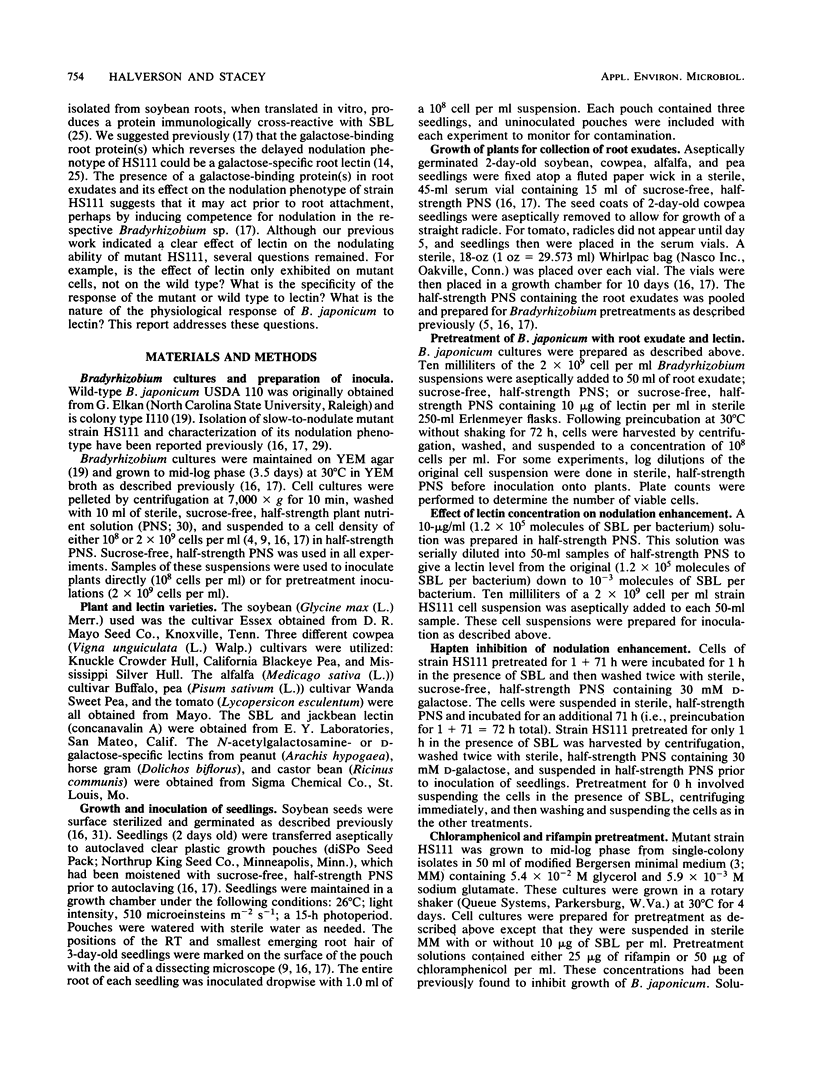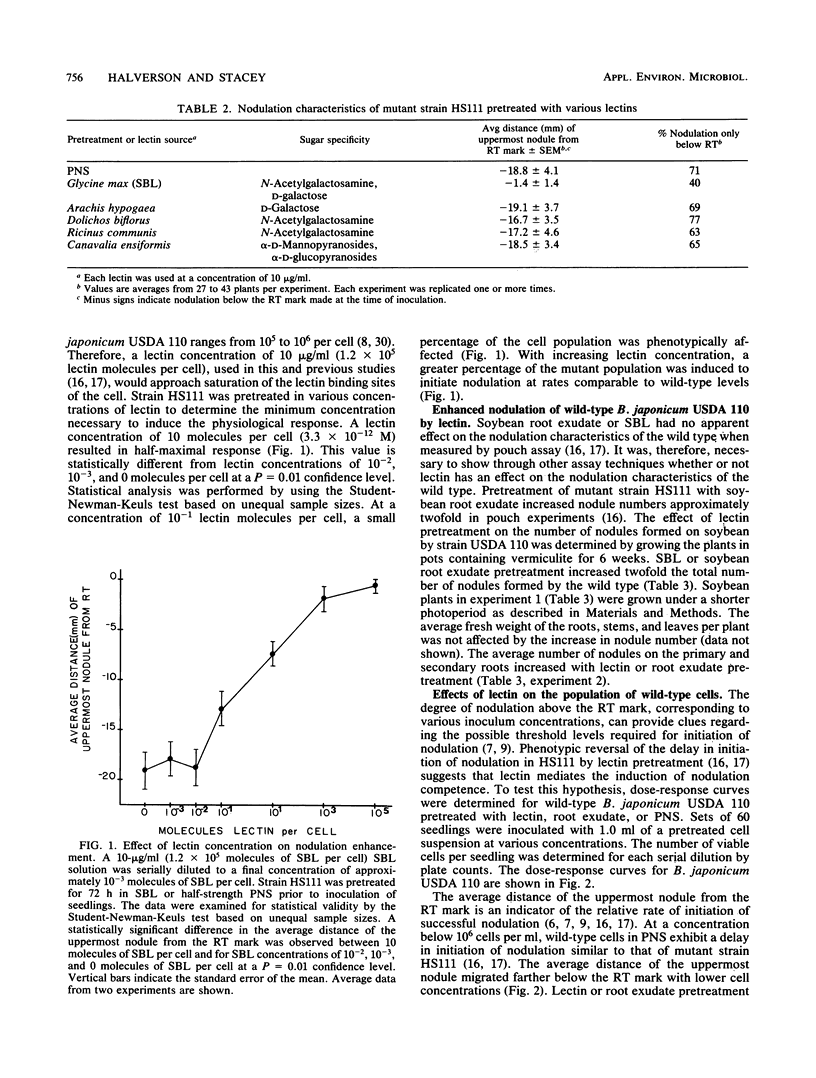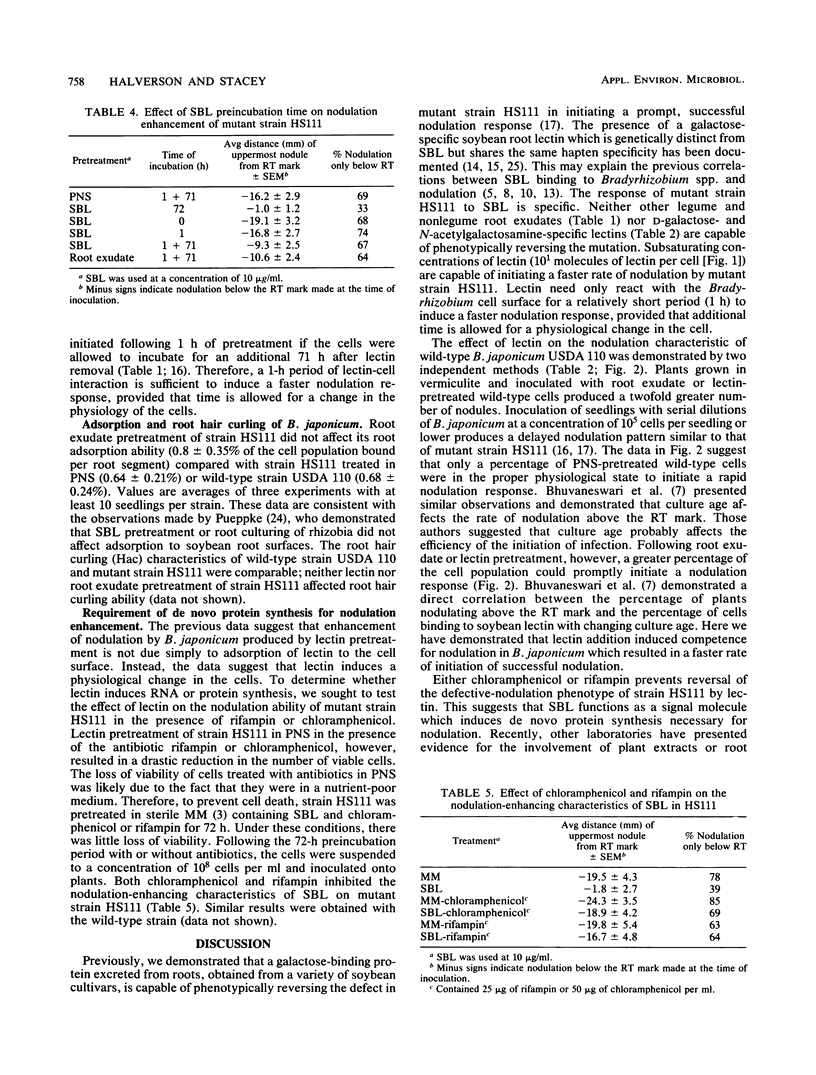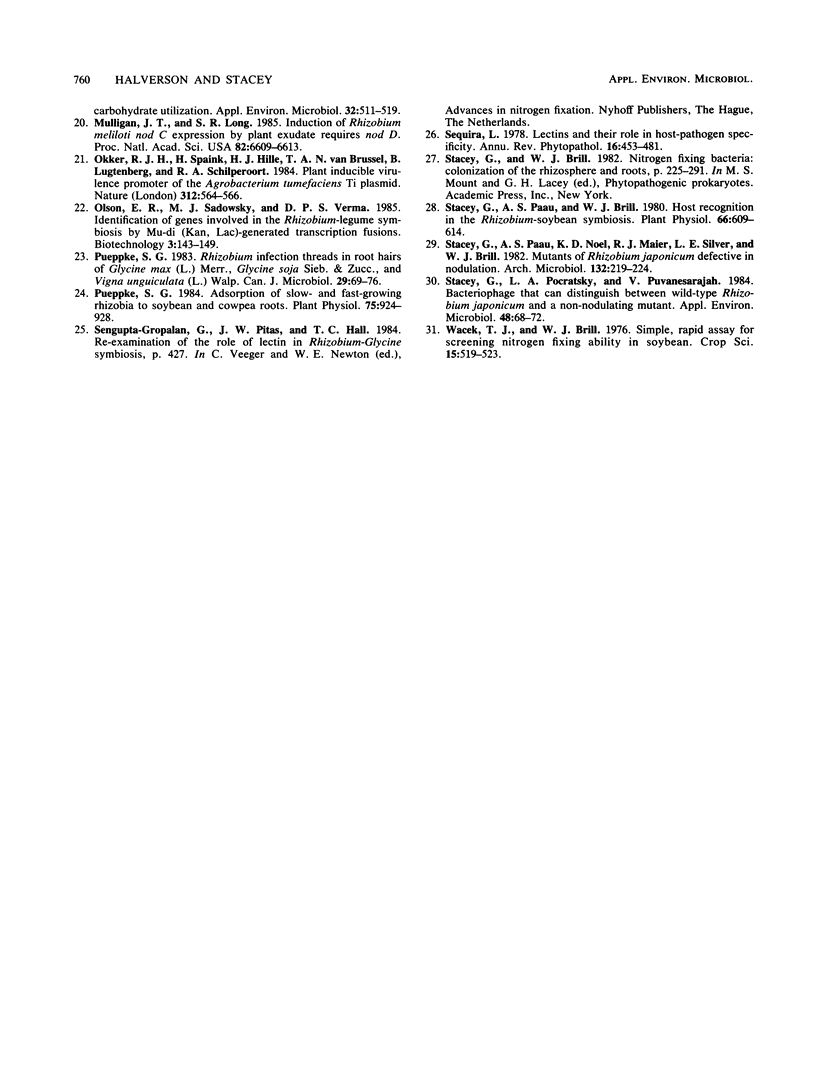Abstract
The nodulation characteristics of wild-type Bradyrhizobium japonicum USDA 110 and mutant strain HS111 were examined. Mutant strain HS111 exhibits a delayed-nodulation phenotype, a result of its inability to initiate successful nodulation promptly following inoculation of the soybean root. Previously, we showed that the defect in initiation of infection leading to subsequent nodulation which is found in HS111 can be phenotypically reversed by pretreatment with soybean root exudate or soybean seed lectin. This effect is not seen after pretreatment with root exudates and lectins obtained from other plant species. Treatment of strain HS111 with as little as 10 soybean seed lectin molecules per bacterium (3.3 X 10 (-12) M) resulted in enhancement of nodule formation. Pretreatment of wild-type B. japonicum USDA 110 with soybean root exudate or seed lectin increased nodule numbers twofold on 6-week-old plants. Wild-type strain USDA 110 cells inoculated at 10(4) cells per seedling exhibited a delay in initiation of infection leading to subsequent nodulation. Wild-type cells pretreated in soybean root exudates or seed lectin did not exhibit a delay in nodulation at this cell concentration. Mutant strain HS111 pretreated in seed lectin for 0 or 1 h, followed by washing with the hapten D-galactose to remove the lectin, exhibited a delay in initiation of nodulation. Phenotypic reversal of the delayed-nodulation phenotype exhibited by strain HS111 was seen if incubation was continued for an additional 71 h in plant nutrient solution following 1 h of lectin pretreatment. Reversal of the delayed-nodulation phenotype of HS111 through lectin pretreatment was prevented by chloramphenicol or rifampin.(ABSTRACT TRUNCATED AT 250 WORDS)
Full text
PDF







Selected References
These references are in PubMed. This may not be the complete list of references from this article.
- Bhagwat A. A., Thomas J. Legume-Rhizobium interactions: cowpea root exudate elicits faster nodulation response by Rhizobium species. Appl Environ Microbiol. 1982 Apr;43(4):800–805. doi: 10.1128/aem.43.4.800-805.1982. [DOI] [PMC free article] [PubMed] [Google Scholar]
- Bhuvaneswari T. V., Bauer W. D. Role of Lectins in Plant-Microorganism Interactions: III. Influence of Rhizosphere/Rhizoplane Culture Conditions on the Soybean Lectin-binding Properties of Rhizobia. Plant Physiol. 1978 Jul;62(1):71–74. doi: 10.1104/pp.62.1.71. [DOI] [PMC free article] [PubMed] [Google Scholar]
- Bhuvaneswari T. V., Bhagwat A. A., Bauer W. D. Transient susceptibility of root cells in four common legumes to nodulation by rhizobia. Plant Physiol. 1981 Nov;68(5):1144–1149. doi: 10.1104/pp.68.5.1144. [DOI] [PMC free article] [PubMed] [Google Scholar]
- Bhuvaneswari T. V., Mills K. K., Crist D. K., Evans W. R., Bauer W. D. Effects of culture age on symbiotic infectivity of Rhizobium japonicum. J Bacteriol. 1983 Jan;153(1):443–451. doi: 10.1128/jb.153.1.443-451.1983. [DOI] [PMC free article] [PubMed] [Google Scholar]
- Bhuvaneswari T. V., Pueppke S. G., Bauer W. D. Role of lectins in plant-microorganism interactions: I. Binding of soybean lectin to rhizobia. Plant Physiol. 1977 Oct;60(4):486–491. doi: 10.1104/pp.60.4.486. [DOI] [PMC free article] [PubMed] [Google Scholar]
- Bhuvaneswari T. V., Turgeon B. G., Bauer W. D. Early Events in the Infection of Soybean (Glycine max L. Merr) by Rhizobium japonicum: I. LOCALIZATION OF INFECTIBLE ROOT CELLS. Plant Physiol. 1980 Dec;66(6):1027–1031. doi: 10.1104/pp.66.6.1027. [DOI] [PMC free article] [PubMed] [Google Scholar]
- Bohlool B. B., Schmidt E. L. Lectins: a possible basis for specificity in the Rhizobium--legume root nodule symbiosis. Science. 1974 Jul 19;185(4147):269–271. doi: 10.1126/science.185.4147.269. [DOI] [PubMed] [Google Scholar]
- Dazzo F. B., Hubbell D. H. Cross-reactive antigens and lectin as determinants of symbiotic specificity in the Rhizobium-clover association. Appl Microbiol. 1975 Dec;30(6):1017–1033. doi: 10.1128/am.30.6.1017-1033.1975. [DOI] [PMC free article] [PubMed] [Google Scholar]
- Gade W., Jack M. A., Dahl J. B., Schmidt E. L., Wold F. The isolation and characterization of a root lectin from soybean (Glycine max (L), cultivar Chippewa). J Biol Chem. 1981 Dec 25;256(24):12905–12910. [PubMed] [Google Scholar]
- Goldberg R. B., Hoschek G., Vodkin L. O. An insertion sequence blocks the expression of a soybean lectin gene. Cell. 1983 Jun;33(2):465–475. doi: 10.1016/0092-8674(83)90428-2. [DOI] [PubMed] [Google Scholar]
- Halverson L. J., Stacey G. Host recognition in the Rhizobium-soybean symbiosis : evidence for the involvement of lectin in nodulation. Plant Physiol. 1985 Mar;77(3):621–625. doi: 10.1104/pp.77.3.621. [DOI] [PMC free article] [PubMed] [Google Scholar]
- Halverson L. J., Stacey G. Host recognition in the Rhizobium-soybean symbiosis: detection of a protein factor in soybean root exudate which is involved in the nodulation process. Plant Physiol. 1984 Jan;74(1):84–89. doi: 10.1104/pp.74.1.84. [DOI] [PMC free article] [PubMed] [Google Scholar]
- Kuykendall L. D., Elkan G. H. Rhizobium japonicum derivatives differing in nitrogen-fixing efficiency and carbohydrate utilization. Appl Environ Microbiol. 1976 Oct;32(4):511–519. doi: 10.1128/aem.32.4.511-519.1976. [DOI] [PMC free article] [PubMed] [Google Scholar]
- Maier R. C., Norris H. J. Glassy cell carcinoma of the cervix. Obstet Gynecol. 1982 Aug;60(2):219–224. [PubMed] [Google Scholar]
- Mulligan J. T., Long S. R. Induction of Rhizobium meliloti nodC expression by plant exudate requires nodD. Proc Natl Acad Sci U S A. 1985 Oct;82(19):6609–6613. doi: 10.1073/pnas.82.19.6609. [DOI] [PMC free article] [PubMed] [Google Scholar]
- Okker R. J., Spaink H., Hille J., van Brussel T. A., Lugtenberg B., Schilperoort R. A. Plant-inducible virulence promoter of the Agrobacterium tumefaciens Ti plasmid. Nature. 1984 Dec 6;312(5994):564–566. doi: 10.1038/312564a0. [DOI] [PubMed] [Google Scholar]
- Pueppke S. G. Adsorption of slow- and fast-growing rhizobia to soybean and cowpea roots. Plant Physiol. 1984 Aug;75(4):924–928. doi: 10.1104/pp.75.4.924. [DOI] [PMC free article] [PubMed] [Google Scholar]
- Stacey G., Paau A. S., Brill W. J. Host recognition in the Rhizobium-soybean symbiosis. Plant Physiol. 1980 Oct;66(4):609–614. doi: 10.1104/pp.66.4.609. [DOI] [PMC free article] [PubMed] [Google Scholar]
- Stacey G., Pocratsky L. A., Puvanesarajah V. Bacteriophage that can distinguish between wild-type Rhizobium japonicum and a non-nodulating mutant. Appl Environ Microbiol. 1984 Jul;48(1):68–72. doi: 10.1128/aem.48.1.68-72.1984. [DOI] [PMC free article] [PubMed] [Google Scholar]


